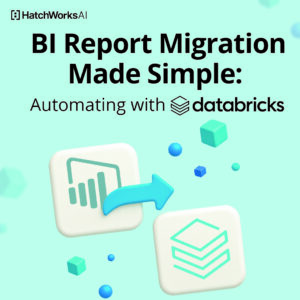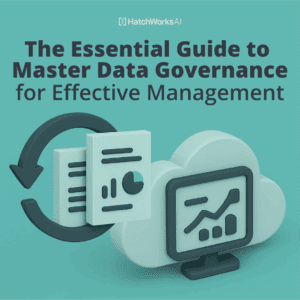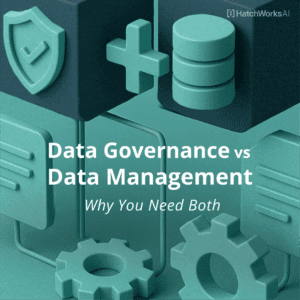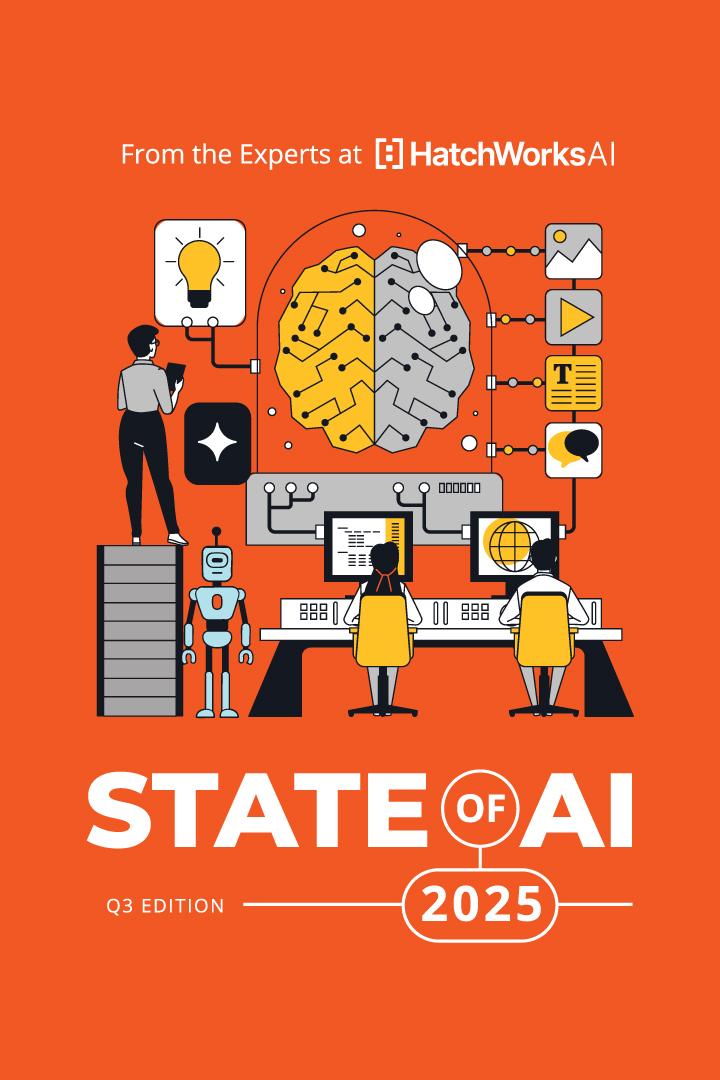You can’t find the numbers you need for the quarterly report, so you pull from three different systems and hope they match.
Your team wastes hours cleaning spreadsheets before they can even start analysis.
A sales rep accidentally emails outdated pricing to a customer because no one knew the doc in SharePoint was two versions old.
Then legal calls—they need documentation for a client dispute, but it was deleted six months ago because there wasn’t a proper retention policy in place.
And that’s just a Tuesday.
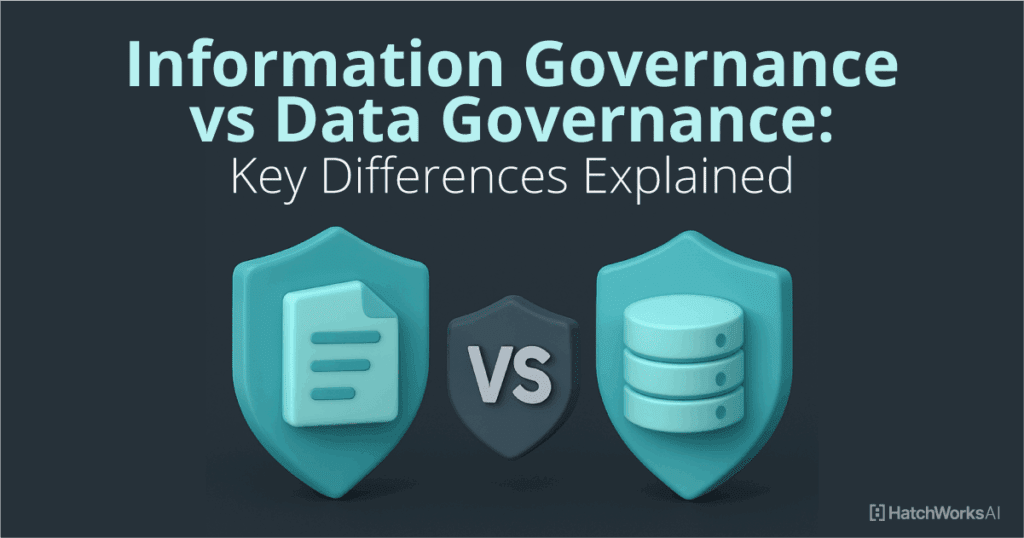
The truth is, poor governance doesn’t show up all at once. It creeps in quietly, through siloed systems, unclear ownership, and outdated processes. Then one day, a missed opportunity or a regulatory fine makes it painfully apparent.
Data governance and information governance prevent all that.
In this guide, we’ll break down the difference between information and data governance, show you how they work together, and share practical steps to implement both.
Information Governance vs Data Governance – Plainly Explained
When organizations look to manage their data and information, two terms come into play: data governance and information governance.
At first, they appear similar. Data is information, after all. But not all information is data.
So what’s the difference?
Data governance is the formal management of data within your enterprise.
Its core objective is to ensure your data, whether structured or unstructured, is available, reliable, secure, and usable at all times.
It requires setting processes, standards, and roles to oversee how data is collected, stored, accessed, and ultimately discarded. And the whole point is to treat your data as the valuable asset it is. Because of that, it’s a critical part of any organization’s data management strategy.
Information Governance, on the other hand, takes a broader view.
It encompasses data governance but expands further, managing not just data but all forms of information your organization holds.
This includes structured and unstructured data, documents, records, emails, and digital communications.
Information governance provides a comprehensive framework of strategies, policies, and procedures aimed at maximizing the value of all organizational information, ensuring it effectively supports compliance requirements and strategic business goals.
Through clear policies, controls, and management oversight, information governance dictates how all organizational information—beyond just data—is handled, protected, and utilized.
It’s especially useful for regulatory compliance in financial institutions.
Key Differences Between Data Governance and Information Governance
| Category | Data Governance | Information Governance |
|---|---|---|
|
Scope
|
Data governance focuses on technical data management for structured and unstructured data
|
Encompasses all information assets, including data, documents, records, and communications. Ultimately, overseeing how data is used and protected
|
|
Goals
|
Data governance emphasizes data quality and usability
|
Information governance prioritizes compliance and risk management.
|
|
Stakeholders
|
Involves IT teams, data engineers, and analysts
|
Involves legal teams, compliance officers, executive leadership, and risk management teams
|
|
Policies and Procedures
|
Defines data collection, storage, access, and disposal standards
|
Establishes enterprise-wide rules for document management, record retention, and ethical information use
|
|
Impact
|
Drives operational efficiency and data-driven decision-making
|
Aligns information use with strategic objectives and regulatory obligations
|
|
Examples of Implementation
|
Centralized data catalog, defined data quality metrics, and clear ownership structures
|
Legal defensibility for deleted records, enterprise retention schedules, and communication governance policies
|
Core Principles of Data Governance
The foundation of data governance rests on a few key principles that help organizations maintain control and reliability over their data:
Data Quality: High-quality data is accurate, consistent, and reliable, giving teams confidence in the insights they draw from it.
Access Control: Establishing clear rules for who can view, edit, or manage specific datasets helps protect sensitive information and prevent misuse.
Data Lineage: Tracking the origin, movement, and transformations of data helps maintain transparency, troubleshoot issues, and meet audit requirements.
To guarantee the efficacy of data governance, organizations rely on industry-recognized models like DAMA-DMBOK and EDM Council’s DCAM. They all offer structured approaches to developing and maintaining strong data governance practices.
Core Principles of Information Governance
Information governance builds on data governance with added layers of oversight and strategy for all types of organizational information:
Compliance: Organizations must meet regulatory and legal standards (such as HIPAA or SOX). Strong information governance helps ensure documentation, records, and communications meet these strict requirements.
Data Lifecycle Management: Every piece of information has a lifecycle. Policies for retention and deletion ensure that data and documents are kept as long as needed and securely disposed of when they are not.
Ethical Use: Beyond legal compliance, organizations need to define policies for the responsible, fair, and ethical handling of information, especially as AI and automation become more prevalent.
And there are frameworks to follow here too. ARMA International’s Information Governance Principles provide a solid foundation for building policies that balance compliance, security, and business value.
Why Businesses Need Both Information Governance and Data Governance in 2025
While data governance and information governance serve different purposes, they are complementary frameworks that work best in tandem.
Neglecting one over the other can expose businesses to serious risks. Without strong data governance, organizations risk basing decisions on incomplete or inaccurate data, leading to missed opportunities or costly mistakes. Without robust information governance, even the best-managed data can become a liability if mishandled, resulting in legal penalties, regulatory fines, or reputational damage.
Take, for example, a financial institution. Data governance ensures that customer and transaction data are accurate and up to date, supporting everything from investment decisions to loan approvals.
At the same time, information governance ensures that this data is stored securely, accessed only by authorized personnel, and used in compliance with strict financial regulations. Both frameworks working together enable the institution to make smart decisions confidently, while avoiding legal and compliance pitfalls.
Implementing Data Governance and Information Governance
Implementing both data and information governance involves defining clear policies, roles, and responsibilities, implementing the right tools and technologies, and fostering a culture that values data and information as critical business assets:
Start by defining clear policies, roles, and responsibilities.
Rather than just drafting policies and letting them sit in a shared drive, make them part of how people work. Who owns what data? Who signs off on changes? Who’s responsible when something goes wrong? Answering these questions upfront and sharing them widely saves confusion down the road.
Data stewards, compliance officers, and executives should all understand their part in maintaining both the accuracy of data and the proper handling of all information assets.
Then, invest in the right tools and technologies.
You probably have tools in place already. The question is whether they talk to each other and support the processes you’re trying to enforce.
Platforms like Databricks can play a pivotal role here by helping organizations manage large volumes of structured and unstructured data, while also supporting advanced analytics and governance workflows.
We always recommend them to our clients and have built out services to help you manage and migrate data through their platform. To learn more about why we trust them and how we work alongside them, check this article out.
Bring governance into everyday conversations.
If governance only comes up during audits or quarterly reviews, it won’t stick. Show your teams how governance makes their roles easier, like how they’ll experience fewer errors, faster decision-making, and less stress when regulators come calling.
Celebrate wins when teams get it right, and share stories of how good governance has made a tangible difference.
Finally, keep evolving.
Governance isn’t static. Business priorities shift, data grows, and regulations change. Set up regular check-ins with cross-functional teams to assess what’s working and what’s not. Don’t be afraid to retire outdated business processes or policies if they’re slowing you down.
The most effective governance strategies feel like they’re part of the rhythm of the business, not extra work layered on top.
Benefits of Data Governance and Information Governance
When you take managing data and information seriously and invest in both governance frameworks, the payoff shows up everywhere. From the boardroom to day-to-day operations, here are some of the key benefits you can expect:
Improved Data Quality and Data Security
Without accurate data, even the best strategies fall apart. Data governance helps you maintain high data accuracy standards across customer data, financial data, and operational records. Pair that with strong information governance, and you’ve got clear rules around how this data is stored, shared, and protected.
Ultimately, that reduces the risk of data breaches and keeps you compliant with regulations. All your organization’s critical data assets are secure.
Faster, More Confident Decision-making
When people trust the data and know it’s being used responsibly, they spend less time second-guessing and more time acting.
Whether it’s customer data, financial data, or something else entirely, your teams can lead with confidence.
Better Outcomes from AI and Analytics Initiatives
The quality of your AI models and analytics depends entirely on the quality and governance of the data feeding them.
We see this firsthand when working with Databricks projects. Solid governance makes everything faster, cleaner, and more impactful.
Greater customer trust
Customers want to know their data is safe. Proactively managing data and information, meeting legal and regulatory requirements, and having transparent data-handling policies builds trust that keeps customers coming back. It also helps you avoid the fallout of data breaches, which can erode loyalty in an instant.
Scalability that doesn’t break things
Growth is exciting, but without governance, it can quickly lead to chaos. As customer data, financial data, and other critical information multiply, governance helps maintain order.
It ensures that new business lines or acquisitions can integrate into existing systems cleanly, that data quality remains high as volumes increase, and that regulatory requirements are still met, no matter how fast you scale
Challenges in Implementing Governance Strategies
Whether you’re focusing on data governance, information governance, or both, here are some common roadblocks and ways to overcome them.
For Data Governance:
Fragmented data sources and silos
It’s hard to govern what you can’t see. When data lives in disconnected systems or when teams create their own reports and definitions, consistency falls apart.
How you can solve it: Start with a unified data catalog that maps where critical data lives and how it’s used. Tools like Databricks can help bring fragmented data together into a central, governed platform, giving your teams visibility and shared understanding.
Resistance to standardized processes
Not every team wants to give up their way of doing things, especially if governance feels like a blocker rather than a benefit.
How you can solve it: Bring teams into the process early. Show them how governance improves their workflows (like fewer reporting errors or faster access to data). Together, you can build governance policies collaboratively and highlight small wins to gain momentum.
For Information Governance
Keeping up with changing regulations
Regulatory requirements, from GDPR to HIPAA to SOX, are constantly evolving. It’s easy to fall behind, especially without a clear owner or system for updates.
How you can solve it: Appoint a cross-functional governance committee that includes legal, compliance, and data leaders. Use policy automation tools and dashboards to track regulation changes and flag areas where updates are needed. Schedule regular reviews instead of waiting for audits.
Balancing business goals with compliance requirements
Sometimes governance can feel like it slows down innovation or makes it harder to move quickly.
How you can solve it: Reframe governance as an enabler, not an obstacle. Use tiered governance models that allow flexibility where risk is low but tighten controls where stakes are high (e.g., financial data, customer data).
Make compliance part of project planning from the start and not something tacked on at the end.
Govern Your Data with Confidence – Get HatchWorks AI
At HatchWorks, we help businesses bring clarity and control to the way they manage data and information, using tools like Databricks to drive smarter decisions, stronger compliance, and better business outcomes.
We also help them combine the power of their data (something no competitor has) with the power of AI.
Ready to turn governance into a strategic advantage? Let’s talk.
Get Your Data AI Ready
Partner with HatchWorks AI to assess your AI Data Readiness and Governance to create a clear path to AI success.
